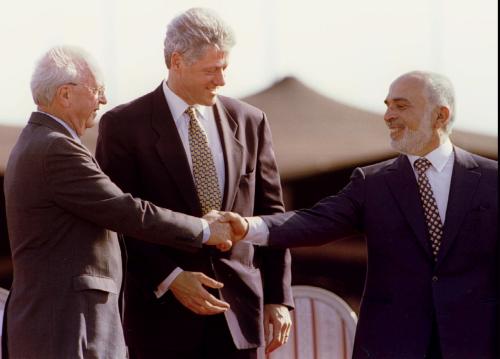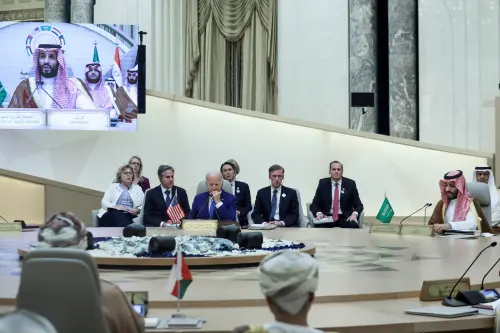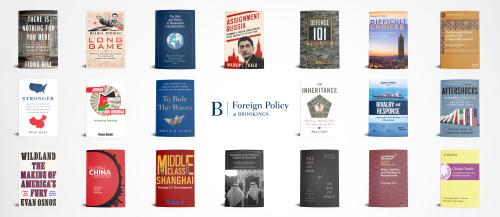I was in Aqaba, Jordan when the Oslo Accords were signed at the White House in September 1993. There was no joy in Jordan—only a profound feeling of betrayal at a secret agreement negotiated without the knowledge of the country most affected by the outcome. Ironically, once Jordan’s King Hussein overcame his anger, he and his kingdom would be the lasting beneficiary of a deal gone sour for everyone else.
America’s relations with Jordan deteriorated sharply in 1990 when Amman tilted toward Baghdad after the Iraqi invasion of Kuwait. The American public and Congress were hostile to King Hussein for his perceived embrace of Iraqi President Saddam Hussein. President Bill Clinton was eager to put the past behind in 1993 and restore the usual harmony in the U.S.-Jordan relationship, and I was in Jordan on behalf of the National Security Council to try to patch things up. (Coincidentally, Brent Scowcroft had sent me a year earlier on the same mission.)
The Jordanians were focused on the news from Norway, however, not on Iraq. Jordan had played an important role in the Madrid peace process by leading a joint delegation with the Palestinians, thereby giving the Palestinian leadership buy-in to the process. The news that Palestinian leader Yasser Arafat had cut a deal behind King Hussein’s back was irritating but not unexpected. Arafat had been betraying Hussein since the late 1960s, and the king expected nothing good of his Palestinian partner.
Nor could the king blame Clinton, who had also been cut out of Oslo until the deal was done. Hussein also regarded the new president as inexperienced and not yet learned in the complexities of the Middle East.
Hussein’s real anger was directed at Israel and especially Shimon Peres, the architect of the Oslo process. The king regarded Peres as a publicity-seeker, not a strategic thinker. Oslo avoided the hard issues and was fraught with contradictions. Peres had forgotten Jordan’s interests, the king believed, and he was no longer trustworthy.
But the deal did free Jordan to do its own agreement with Israel. If the Palestinians were making an interim peace with Israel, Jordan would do one better and sign a peace treaty. Two weeks after the White House ceremony, King Hussein hosted Israeli Prime Minister Yitzhak Rabin in Aqaba at the royal palace to agree to a format for negotiations for a treaty.
The crucial player in the negotiations was Efraim Halevy, then the deputy director of the Israeli secret intelligence service known as the Mossad. Halevy had been chief of liaison relations for years in the Mossad and had considerable expertise. The king trusted Halevy, and the back channel between the two—which cut out the Americans—was the key to success. Crown Prince Hassan was his brother’s top adviser in the negotiations.
The king had also just learned, in November 1992, that he had cancer. Hussein underwent care and was undoubtedly more concerned than ever about his legacy and leaving his successor a nation at peace.
The turning point in the negotiations came during a secret summit in London on May 19, 1994 between Rabin and Hussein, with Halevy and Crown Prince Hassan present. Israel proposed to grant Jordan a privileged position in looking after the Muslim holy sites in Jerusalem. Work began on drafting the treaty.
Clinton strongly supported the process, promising debt relief for Jordan and military aid (including F-16 fighters). Israel lobbied Congress to approve the aid. King Hussein met with President Clinton in Washington in June, and Hussein said it was the best meeting he had with an American president since Dwight Eisenhower. Since Ike had saved the king’s throne more than once in the 1950s, it was indeed high praise.
The biggest obstacle to a treaty was land. Israel had encroached on 380 square kilometers of territory south of the Dead Sea over the years. The treaty restored Jordan’s sovereignty while allowing Israel to lease back for 25 years some of the land for farming. The treaty also specifically endorsed Jordan’s special role in Jerusalem. For the Hashemite dynasty, which claims direct lineage from the Prophet Muhammad, this is a critical issue.
Just 13 months after the Oslo ceremony on the White House lawn, the treaty for peace between Israel and the Hashemite Kingdom of Jordan was signed on October 26, 1994 in Wadi Araba. The treaty opened all the doors in Washington for Jordan. Debt relief was passed, and a squadron of F-16s was en route to the Royal Jordanian Air Force; all with the support of the Israeli government.
The treaty has never been popular with the Jordanian people. It has often been denounced as favorable to Israel. Nonetheless, it is now a fixture of the political landscape and it has survived numerous crises and disappointments.
Today Jordan’s relations with the United States are again in jeopardy. Donald Trump’s decisions to move the embassy to Jerusalem and de-fund the United Nations Relief and Works Agency (UNRWA) have come against King Abdullah’s strong opposition. Jordan feels isolated from its traditional relationship as it faces the turbulence of crisis all around it. Oslo today is a shattered dream, while the Jordan-Israel treaty is for now still in place. King Hussein, the “plucky little king” who ruled the Hashemite Kingdom of Jordan for a half century, seized the Oslo day.







Commentary
The Oslo Accords at 25: The view from Jordan
September 11, 2018